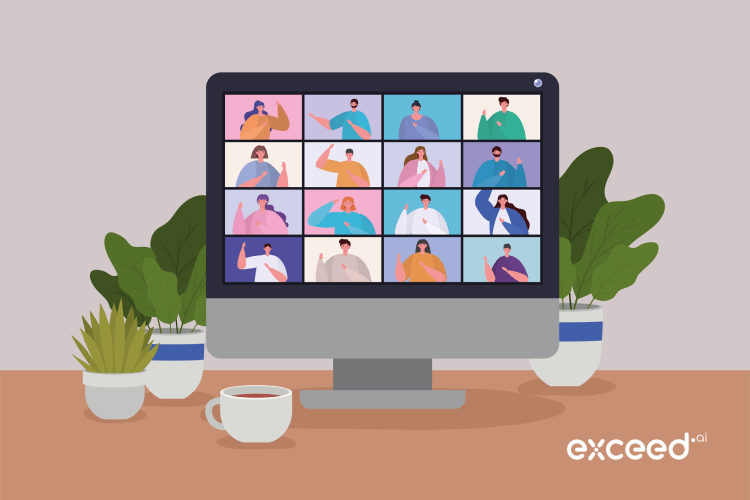Your virtual event is over.
People attended, people engaged, people left satisfied. Woo-hoo!
Time to sink into a comfortable chair with a glass of wine, right?
Not yet.
We’ll give you five minutes to revel in the glory and/or work out all that tension in your shoulders. But then it’s right back to work – as follow-up is arguably the most important component of your event when it comes to sales.
Here we’ve brought you five different concrete actions that each contribute to acing virtual event follow-up and maximizing your potential for sales.
1. Reach out right away
Prompt outreach post-event is critical.
You’re probably familiar with the classic online sales study done by the Harvard Business Review in 2011, which discovered that companies that responded to online leads within an hour were nearly seven times as likely to qualify the lead as those that tried to contact the customer even an hour later, and more than 60 times as likely to qualify the lead as companies that waited 24 hours or longer.
While virtual event attendance doesn’t require such rapid follow-up, the concept applies here too: people are more receptive to hearing about what you have to offer when their last encounter with you is fresh in their minds.
So get out that first post-event follow-up communication fast – within the first 24 hours after the event.
Keep this first communication simple. For attendees, send a “thank you for attending” email. For no-shows, send a “sorry we missed you” email.
The LiveAgent blog gives a great list of post-event follow-up email subject lines, including:
- Thanks for making [Event Title] a success!
- [Name], thanks for joining us (bonus materials inside!)
- [Name], how did you like the [event type] with [Speaker’s Name]?
- We missed you today at [Event Title]! Here’s the recording
- [Name], too bad you couldn’t join [Event Title]
What should be in this first email?
- Expression of appreciation for their attendance (or of disappointment over their non-attendance)
- A short event recap or highlights
- A photo (even for a webinar, this is almost always possible by taking some screenshot of the presenters)
- Link to post-event page (more about this below in the “Plan post-event content in advance” section)
The aforementioned LiveAgent blog post also provides 10 templates for the content of event follow-up emails. Use or modify them to suit your needs, audience, and communication style.
2. Run a conversational lead nurturing campaign
After your first post-event follow-up communication, you can move right into an extended conversational lead nurturing campaign.
This campaign should directly align with the event, offering content and other resources that connect naturally to the event topic.
For inspiration in crafting your nurture campaign, you can check out the Splash blog’s set sequence of post-event emails.
You can have your SDRs send these emails, but because it’s so time-intensive, potential leads may fall through the cracks or be deliberately relegated to “later.” An AI virtual assistant can come to the rescue here by using conversational AI to carry on this personalized communication – at scale! – and handing the lead off to a sales rep if they are qualified and when they show true interest in your offering.
3. Segment follow-up based on interests
Get better results from your event or webinar follow-up email sequence by tailoring your emails to each attendee’s interests.
You can identify interests and assign segments based on:
Session attendance
If you had more than one session at your virtual event, note which sessions attendees chose to attend, and put them into nurture campaigns that focus on those topics. (You’ll need to create separate nurture campaigns. It’s worth it.)
In-event poll answers
Did you run any live polling during your webinar or conference? Tag your attendees based on how they answered, and use that segmentation to deliver relevant content.
Feedback survey answers
Let’s say that one of your questions is a multiple-choice on “Which topic do you want to hear more about?” Put each respondent in a separate nurture campaign focused on the topic of their choice.
4. Provide value with each follow-up
Of course your end goal for your event follow-up is the ring of the virtual cash register. But beware of making that the sole focus of your emails. Otherwise, you risk sounding like a pushy used car salesman.
What should you do instead?
Provide value. Send emails that your recipients would be glad to receive.
Give tips, strategies, questions, answers, ideas, templates and guidance. Act as a teacher and an advisor.
Remember – you know what your audience is interested in! They came to your event; they may have shown special interest in a particular topic (see “Segment follow-up based on interests” section above). You know what they want!
By making sure that each follow-up communication provides value, you’ll establish your role as a trusted advisor, making your sales offers (when they come) all the more attractive.
5. Plan post-event content in advance
This is the key to all successful virtual event follow-up: post-event content should not be left until post-event.
Since promptness is of the essence (see “Be a fast talker” section above), you need to have your post-event lead engagement strategy set and ready to go into motion the instant you say goodbye to your virtual event attendees.
A post-event webpage is one of your most important pieces of post-event content and should be set up before the event happens, leaving spaces for the content that you’ll only have after the event.
Features of a post-event page should include:
-
- A message of thanks (this you can set up before the event)
- Event highlights or recap (this may need to be done after)
- Key takeaways (this you should be able to do before, at least for the sessions you give)
- Recordings or visual content (before for slide presentations, etc.; after for recordings)
- Photos (after)
- Some statistics, like attendance (after)
- Highlight partners and sponsors (before)
- The ability to share the page and/or content on social media
- A relevant CTA, like signing up for updates about future events
You’ll also want to set up as much as you can of your post-event emails, nurture campaigns, community venues, social media messaging, and any other post-event content.
Follow (up) = the leader!
So many organizations invest in their virtual event marketing and execution but drop the ball when it comes to follow-up. Don’t be that kind of organization.
Planning for and implementing a thought-out virtual event follow-up strategy puts you into a different league. And you’re bound to see the difference in your bottom line.
Now that’s worth celebrating in a comfortable chair with a glass of wine.



![Discover The Best Email AI Assistant [AI Unleashed]](https://exceed.ai/wp-content/uploads/2024/01/1_1-400x250.webp)
![The Power Of AI Sales Agents [Autonomous Reps]](https://exceed.ai/wp-content/uploads/2024/01/happy-sales-agent-smiling-400x250.webp)